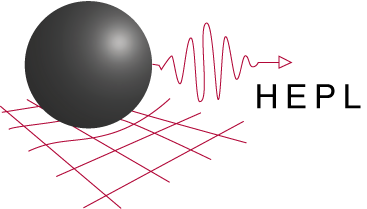News & Events
HEPL - KIPAC SEMINAR
Visiting researcher, Hansen Experimental Physics Laboratory, Stanford University
PhD candidate, University of Stuttgart and Science Missions & Systems EADS Astrium
“Achieving disturbance reduction for future drag-free missions. ”
In 2004 he joined EADS Astrium in the Science Missions and Systems Department. Since then he worked on LISA Pathfinder (drag-free and attitude control system, experiment controller, experiment performance) and LISA.
He is a Ph.D. candidate at the University of Stuttgart (Germany), with a thesis on alternative gravitational reference sensor concepts for LISA, and is currently a visiting researcher at HEPL working on a trade study for the LISA payload. His main research interests are GW observatories and drag-free missions.
Abstract: Future drag-free missions for space-based experiments in gravitational physics require a Gravitational Reference Sensor (GRS) with extremely demanding sensing and disturbance reduction requirements.
A GRS with a cubical proof mass is the current baseline for the Laser Interferometer Space Antenna (LISA) and has reached a high level of maturity. Nevertheless, several promising concepts have been proposed with potential applications also beyond LISA. The general motivation is to exploit the possibility of achieving improved performance, and, ultimately understand how low acceleration noise can be pushed with realistic designs for future missions.
I will refer to LISA but discuss aspects of disturbance reduction systems that can largely and generally apply to future drag-free missions. I will discuss disturbance reduction requirements for LISA, describe two different payload designs, compare expected strain sensitivity in the low-frequency part of the LISA band (dominated by acceleration noise) and ultimately discuss advantages and disadvantages of each of these two concepts in achieving disturbance reduction for LISA (and beyond).
Wednesday, October 24th, 4:00- 5:30 pm
Light refreshments available 4pm; Presentation begins 4:15pm. Open to all.
Join our HEPL Seminar Mailing list!
Send an email to majordomo@lists.stanford.edu and type
subscribe heplseminars user@stanford.edu
in the body of the message where user@stanford.edu is your email address
You will receive an email confirmation. We hope to see you at a HEPL Seminar soon.
Previous HEPL Seminars 2004, 2005, 2006, 2007, 2008:
Dr. Martin Tajmar, MSS
Head of Space Propulsion & Advanced Concepts
Austrian Research Centers GmbH - ARC
“LISA Thrusters and the Search for Frame Dragging at Low Temperatures at ARC”
Wednesday, February 20, 2008
Dr. Stefan Funk
Assistant Professor, Physics, Stanford University and SLAC
“Gamma-ray astronomy: Status and Future Directions”
Wednesday, January 30, 2008
Dr. Joerg Wagner
University of Stuttgart
“The Origin of the Modern Gyroscope: Bohnenberger's Machine and the Scientific Work of its Inventor”
January 16, 2008
Professor Bob Bingham
Rutherford Appleton Laboratory
“Probing Quantum Gravity Using Matter”
Wednesday, December 12, 2007
Richard N. Boyd
Science Director, National Ignition Facility
Lawrence Livermore National Laboratory
“Creating a Star in the Laboratory: the National Ignition Facility”
Wednesday, November 28, 2007
Domenico Gerardi
Visiting researcher, Hansen Experimental Physics Laboratory, Stanford University
PhD candidate, University of Stuttgart and Science Missions & Systems EADS Astrium
“Achieving disturbance reduction for future drag-free missions. ”
Wednesday, October 24, 2007
Fabio Scardigli
Department of Physics, University of Milano, Italy
"The Equivalence Principle, the Uncertainty Principle and Some Fundamental Physics Questions"
Wednesday, May 23, 2007
Dr. Gregory P. Crawford, Dean of Engineering and Professor of Engineering & Physics
Brown University, Division of Engineering
“In Vivo Spectroscopy for Blood Analyte Monitoring”
Wednesday, April 25, 2007
Professor C.W. Francis Everitt
W.W. Hansen Experimental Physics Laboratory, Stanford University
“Maxwell at 175 ”
Wednesday, March 14, 2007
Paul Brink
Department of Physics, Stanford University speaking for the (Super)CDMS collaboration
“Present status and future plans of the Cryogenic Dark Matter Search (CDMS)”
Wednesday, February 28, 2007
Alfred Vogel
Institute of Biomedical Optics University of Lübeck, Germany
“New findings on plasma and cavity generation in aqueous media with fs and ns laser pulses, and their applications in cell surgery"
Thursday, January 25, 2007
Dr. Dan McCleese
Chief Scientist, Jet Propulsion Laboratory
“Recent Results and Future Direction of the Exploration of Mars"
Tuesday, September 26, 2006
Ned Wright
Professor of Physics and Astronomy, UCLA
What's New in Cosmology?
Thursday 9 March 2006
Peter Michelson
Stanford University
GLAST: The Gamma-ray Large Area Space Telescope Mission
Seminar and Tour
Thursday 16 Feb 2006
Robert L. Byer
Stanford University
"Acceleration of Electrons with Visible Light"
Wednesday 1 Feb 2006
Dr. Nicholas White
Chief,
Laboratory for High Astrophysics NASA Goddard Space Flight Center
“The NASA Beyond Einstein Program”
Wed 5 Oct 2005
Ulrich Schreiber, Forschungseinrichtung Satellitengeodäsie, TU-München
“High Precision Sagnac Interferometry for Applications in Geoscience ”
Thursday, September 8, 2005
Christopher D. Bass,
Indiana University / IUCF, “Measurement of the Parity-Odd Neutron Spin Rotation in Liquid-4He”
Monday, August 22, 2005
Anne Kinney, Director, Universe Division in the Science Mission Directorate, NASA, "Blue Planets, Black Holes"
Wednesday, 20 July 2005
Dr William Tobin, Department of Physics & Astronomy, University of Canterbury, New Zealand, "Foucault's Gyroscope of 1852"
Friday, 8 April 2005
Rex Geveden, NASA Chief Engineer, Independent Technical Authority
7 April 2005
Shooting the Moon: Probing Fundamental Gravity in the Solar System
Tom Murphy,
UC San Diego 3 March 2005
The GRACE Mission: Status and Science Results John Ries, Senior Research Scientist at the Center for Space Research at The University of Texas at Austin, 14 February 2005.
Hubble Robotic Servicing - Recent Engineering Development, Bill Reeve
Civil Space Director of Advanced Science Programs,
Lockheed Martin, 26 January 2005.
Interferometry for LISA, Daniel Shaddock, PhD, Interferometry Metrology and Optics Group, Jet Propulsion Laboratory, 17 November 2004.
The Large Synoptic Survey Telescope (LSST), Steve Kahn, Deputy Director, Kavli Institute for Particle Astrophysics and Cosmology, 27 October 2004.
HEPL-KIPAC Showcase. 29 September 2004. Agenda


